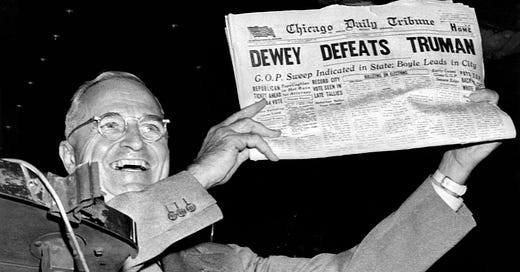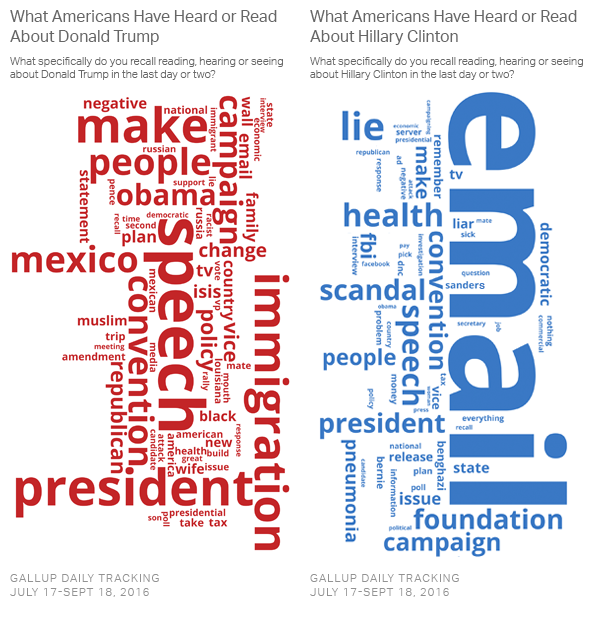For the New Year: Election-Day Countdown.
Three hundred and nine days that will change the world.
Polling and prediction tell us what is “likely” to happen. What will happen depends on each of us, day by day. (Getty Images.)
Happy New Year!
During the fateful 2016 presidential campaign, I produced a series of online updates that I called the “Trump Time Capsules.” Their purpose was to record what people knew about the electoral choice ahead of them—and to do so at a time when no one could know how that election would turn out.
I laid out the logic when I started the series, six months before Election Day:
People will wonder about America in our time. It can be engrossing to look back on dramatic, high-stakes periods in which people were not yet sure where things would lead, to see how they assessed the odds before knowing the outcome. The last few months of the 1968 presidential campaign: would it be Humphrey, Nixon, or conceivably even George Wallace? Or 1964: was there a chance that Goldwater might win? The impeachment countdown for Richard Nixon, in 1974? The Bush-Gore recount watch in 2000?
The Trump campaign this year will probably join that list. The odds are still against his becoming president, but no one can be sure what the next five-plus months will bring. Thus for time-capsule purposes, and not with the idea that this would change a single voter’s mind, I kick off what I intend as a regular feature. Its purpose is to catalogue some of the things Donald Trump says and does that no real president would do.
By election day, the series had reached 152 installments. Over the months its emphasis shifted away from the outlier statements and threats that Trump himself was making, mainly because there were so many of them. I began writing more about the way others were normalizing and accommodating him. Those included the “Vichy Republicans” who denounced Trump in private but in public cravenly feared to cross him. It also included parts of the press whose “false equivalence” instincts led them to bracket Trump’s historic menace with Hillary Clinton’s failings and missteps. Shortly before the election Gallup released its now-famous word-clouds dramatizing the imbalance.
I announced the finale of that series here, shortly before Americans went to the polls. I find it unsettling to re-read that item from seven years ago, in light of what we have seen, learned, and absorbed since then:
No one looking back on the America of 2016 will think that the real question its voters should have been grappling with was how Hillary Clinton handled her email. But TV has told us more about this issue than about [anything else].….
So this chronicle ends as tens of millions of early votes have already been cast; with just one weekend separating us from official election day; and with all the information anyone could want already on record about these two candidates.
We know the choice we are making. People who are standing with Trump are doing so with eyes wide open. Of course so are people who are standing with Hillary Clinton. But her strengths and weaknesses are within the range we have seen from most past presidents. Trump’s are outside the known range.
That final entry noted that the election was on November 8 and concluded:
Let’s hope that starting on November 9 we can look back with chastened wonder about how close Trump came, and with cautionary guidance about the next steps toward self-governing reform.
Meanwhile read; think; vote.
A journal of our plague year.
That 2016 hope obviously proved to be in vain. Seven years ago the United States went up to a brink, and kept going.
In many ways, the civic fabric has proven resilient since then. The great majority of election results since the one that empowered Trump have broken against him and his enablers.1 Prosecutors and juries across the country are doing their jobs. Many of the “fake electors” Trump was relying on to keep him in office are in legal trouble themselves. Many of the rioters he incited three years ago are now doing prison time. The local-level economic and civic renewal Deb and I have chronicled is ever more fully underway.
Much of the American system has held. For now. But we don’t know which way the balance might shift.
Three hundred and nine days from now, America’s prospects will look very different than they do as we begin this year—different one way or another. The results will depend on an electorate whose downcast mood contrasts with the strongest economic growth in decades. In the starkest way since Bush v. Gore in 2000, the outcome may be in the hands of a Supreme Court that is less trusted and more politicized than in that era, and far more visibly corrupt. Public information will depend on a mainstream press still struggling to cope with a movement like Trump’s, and social media companies that barely try.
The years after 2024 will depend on what happens to us in these upcoming days, and on what we do in response.
Recording what it is like for us to live through this period—when so much of the nation’s future depends on each of us, but when none of us can know the outcome—is the aspirational theme for this upcoming series. A journal of the plague year, when we can’t yet assess the disease’s final toll. Periodic markers and measures of what people learned and said, of how they responded, of who did what in a time of maximum trial.
I have in mind a range of standing features on how institutions and individuals are meeting this moment’s challenge. Naturally this will include the press, which is the institution I know best and the one that, in theory, can still make real-time corrections. But I have other features in store involving the economy, international relations, the judiciary, and more. I’ll plan to keep writing about the usual range of other topics, and I will look forward to suggestions and responses from readers and we live through this time together.
Let us hope, as I put it seven years ago, that people will look back on these 300-plus days with chastened wonder, and with cautionary guidance about our steps ahead.
I am thinking of the midterms in 2018, when the Democrats picked up 41 seats in the House and seven governorships, while losing two seats in the Senate; the 2020 election, with Joe Biden’s win and Democratic control of both houses of Congress; the runoff elections in Georgia and judicial elections and abortion-rights referenda in Kansas, Wisconsin, Ohio, and elsewhere; and the 2022 midterms. Virtually all of these results were “surprisingly” better for Democrats and progressives than polls and pundits had forecast even days before, as noted here.






Knowing you will be an essential media critic during this period. Hoping your peers in media take notice. Hoping beyond hope they act on your advise. My 'forward' and 'share' buttons are relocated to the center panel, with lights on 'em.
Can’t speak for anyone else, but I’m scared. In general, “the media,” upon which so much of the eventual outcome depends, seems to have learned nothing.